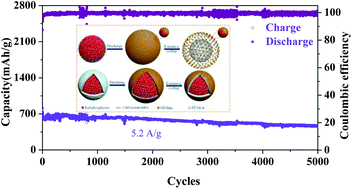A core–shell structure of polydopamine-coated phosphorus–carbon nanotube composite for high-performance sodium-ion batteries†
Abstract
The electrochemical performance of red phosphorus is severely limited by its low electrical conductivity and large-volume-expansion-induced material pulverization and continuous solid electrolyte interphase (SEI) growth. Conductive coating has been regarded as an ideal approach to address these issues. In this paper, we design a rational strategy to improve the sodium storage performance of red phosphorus by in situ coating of a polydopamine layer on phosphorus–carbon nanotube hybrid (P–CNT@PD) via a self-polymerization of dopamine under weak base conditions. The in situ generated PD coating can provide an elastic buffer for accommodating the volume change of active materials and prevent their direct contact with the electrolyte. Due to the conductive and elastic PD coating, the P–CNT@PD composite presents a high rate capacity (1060 mA h g−1 at the second discharge and 730 mA h g−1 after 2000 cycles at 2.6 A g−1) and excellent cycling stability (470 mA h g−1 after 5000 cycles at 5.2 A g−1) as an anode for sodium ion batteries. This facile and scalable synthesis route provides a favorable approach for the mass production of high performance electrodes for sodium ion batteries.



 Please wait while we load your content...
Please wait while we load your content...